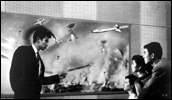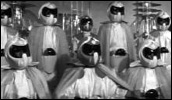The Mysterians
- Year
- 1957
- Original title
- Chikyu Boeigun
- Japanese title
- 地球防衛軍
- Director
- Cast
- Running time
- 85 minutes
- Published
- 6 November 2006



by Tom Mes
The great upshot of the recent release of the original Japanese version of the 1954 Godzilla is that we finally get to see with our own eyes what was rumoured and repeated for so many decades: that this movie about a giant lizard stomping on Tokyo is one of the great humanist, anti-war statements in Japanese film history.
The process of Godzilla's subsequent infantilisation, rendered worse by the dubbing and editing employed to make his adventures palatable to Western eyes, have made the lizard and the kaiju genre he spawned as much as an object of ridicule as one of devoted cult worship. Dismissive platitudes about sweaty men in rubber suits are still frequent.
Now that the truth is starting to reveal itself, though, it is not only the genre's pertinence that is getting recognised, but also its beauty. Certainly, the usual rule of thumb of 80% crap versus 20% quality applies to the kaiju films too, but the great ones are good films by any genre's standard.
It is probably no coincidence that many of the outstanding entries were the work of the same team that created Godzilla, most notably director Ishiro Honda and special effects designer Eiji Tsuburaya (though cinematographer Hajima Koizumi and composer Akira Ifukube certainly also deserve to be noted). Godzilla, Rodan, The Human Vapour, Matango - anyone looking for proof of greatness need only have a look at the work of this group of men. The recent DVD releases of their 1957 production The Mysterians by the British Film Institute in the UK (who also put out Godzilla in a deluxe package) and Media Blasters in the USA further solidifies their status.
The first Toho fantasy film to be shot in widescreen and in colour, the film details the invasion of Earth by the titular race of extraterrestrials. Announced by massive mudslides, elevated levels of radioactivity, and sightings of a giant, bird-like robot, the appearance of the Mysterians' dome-shaped home base is greeted with scepticism by some and wonder by others. After the aliens tell the earthlings that they are the escapees of a planet destroyed by nuclear war, a team of scientists agrees to accept their invitation and come aboard. The Mysterians' offer to share their advanced technology with the people of planet Earth, however, turns out to be a front. It's our planet that offers the invaders something they urgently need: women! Hokum? Sure, but a lot more besides.
The visual upgrade is precisely where much of the beauty of The Mysterians lies. The combined impact is, to put it simply, a feast for the eyes. There is splendour here, in the soft Technicolor palette, the delicate miniatures, the fanciful futuristic machinery, and the glistening costumes. It can be found in the briefest of shots and the most fleeting of moments, as in the cloud formations in the background of a quick shot of jetfighters taking off from a runway. The special effects work is executed not just with professionalism, but with grace: watch the Mysterian robot cause landslides and come to its demise in a hale of sparks, or see the machinery in the alien base literally melt when bombarded with lasers. This is more than craftsmanship; this is beauty.
The qualities of The Mysterians become all the more apparent when placed side-by-side with some of the later entries in the genre, such as the 1977 War in Space (Wakusei Daisenso, conveniently released on DVD around the same time, by US outfit Discotek Media). Made twenty years later in the wake of the Star Wars phenomenon, it employs virtually the same plot as The Mysterians and relies on the same old effects techniques pioneered by Tsuburaya. But it is a pale copy. Grace? Splendour? None of it. War in Space is a plodding film, shot in dreary images, directed, acted, and written without much inspiration, its stale effects routinely executed and looking all the more outdated for it. Jun Fukuda may be the world's second-best known kaiju film director, there exists a large gaping hole between Honda and him in the ranking.
Honda was a man of beliefs, and they infused his films. Where Fukuda seemed to believe mainly in big hair and short skirts, The Mysterians talks of the collaboration between nations and peoples, and expresses the wish that we will learn to use science for constructive means. These messages are echoed in every round of wasted ammunition and in every missile launched in vain. Here was a man who believed in the ideals and potential of the United Nations. Indeed, it could be argued that, just as much as the borderless joy of seeing a big monster on a rampage, it was Honda's frequent use of scenes of multi-lateral deliberation between world leaders and international teams of scientists that made the kaiju films so suitable for export.
If this characteristic has gone on to become a fixture of the genre as a whole, The Mysterians did much to make it so. Perhaps even more than the black and white productions that preceded it, this film provided the blueprint for the genre: in terms of story (the plot would be adopted several times over for films like Godzilla versus Monster Zero / Kaiju Daisenso, 1965, as well as paving the way for a sub-genre of alien invasion films such as Battle in Outer Space / Uchu Daisenso, 1959, and the aforementioned War in Space), in terms of design, in terms of effects, and in terms of cinematography. The Mysterians is, to all intents and purposes, where Japanese sci-fi finds its form, like a stunt player slipping into his most comfortable ever rubber monster suit. It is a welcome reminder of exactly how powerful the genre could be.